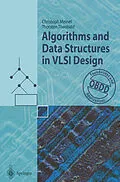One of the main problems in chip design is the huge number of possible combinations of individual chip elements, leading to a combinatorial explosion as chips become more complex. New key results in theoretical computer science and in the design of data structures and efficient algorithms can be applied fruitfully here. The application of ordered binary decision diagrams (OBDDs) has led to dramatic performance improvements in many computer-aided design projects. This textbook provides an introduction to the foundations of this interdisciplinary research area with an emphasis on applications in computer-aided circuit design and formal verification.
Klappentext
One of the main problems in chip design is the enormous number of possible combinations of individual chip elements within a system, and the problem of their compatibility. The recent application of data structures, efficient algorithms, and ordered binary decision diagrams (OBDDs) has proven vital in designing the computer chips of tomorrow. This book provides an introduction to the foundations of this interdisciplinary research area, emphasizing its applications in computer aided circuit design.
Inhalt
1. Introduction.- 2. Basics.- 2.1 Propositions and Predicates.- 2.2 Sets, Relations, and Functions.- 2.3 Graphs.- 2.4 Algorithms and Data Structures.- 2.5 Complexity of Algorithms.- 2.6 Hashing.- 2.7 Finite Automata and Finite State Machines.- 2.8 References.- I. Data Structures for Switching Functions.- 3. Boolean Functions.- 3.1 Boolean Algebra.- 3.2 Boolean Formulas and Boolean Functions.- 3.3 Switching Functions.- 3.3.1 Switching Functions with at Most Two Variables.- 3.3.2 Subfunctions and Shannon's Expansion.- 3.3.3 Visual Representation.- 3.3.4 Monotone Switching Functions.- 3.3.5 Symmetric Functions.- 3.3.6 Threshold Functions.- 3.3.7 Partial Switching Functions.- 3.4 References.- 4. Classical Representations.- 4.1 Truth Tables.- 4.2 Two-Level Normal Forms.- 4.3 Circuits and Formulas.- 4.3.1 Circuits.- 4.3.2 Formulas.- 4.4 Binary Decision Trees and Diagrams.- 4.4.1 Binary Decision Trees.- 4.4.2 Branching Programs.- 4.4.3 Read-Once Branching Programs.- 4.4.4 Complexity of Basic Operations.- 4.5 References.- 5. Requirements on Data Structures in Formal Circuit Verification.- 5.1 Circuit Verification.- 5.2 Formal Verification of Combinational Circuits.- 5.3 Formal Verification of Sequential Circuits.- 5.4 References.- II. OBDDs: An Efficient Data Structure.- 6. OBDDs - Ordered Binary Decision Diagrams.- 6.1 Notation and Examples.- 6.2 Reduced OBDDs: A Canonical Representation of Switching Functions.- 6.3 The Reduction Algorithm.- 6.4 Basic Constructions.- 6.5 Performing Binary Operations and the Equivalence Test.- 6.6 References.- 7. Efficient Implementation of OBDDs.- 7.1 Key Ideas.- 7.1.1 Shared OBDDs.- 7.1.2 Unique Table and Strong Canonicity.- 7.1.3 ITE Algorithm and Computed Table.- 7.1.4 Complemented Edges.- 7.1.5 Standard Triples.- 7.1.6 Memory Management.- 7.2 Some Popular OBDD Packages.- 7.2.1 The OBDD Package of Brace, Rudell, and Bryant.- 7.2.2 The OBDD Package of Long.- 7.2.3 The CUDD Package: Colorado University Decision Diagrams.- 7.3 References.- 8. Influence of the Variable Order on the Complexity of OBDDs.- 8.1 Connection Between Variable Order and OBDD Size.- 8.2 Exponential Lower Bounds.- 8.3 OBDDs with Different Variable Orders.- 8.4 Complexity of Minimization.- 8.5 References.- 9. Optimizing the Variable Order.- 9.1 Heuristics for Constructing Good Variable Orders.- 9.1.1 The Fan-In Heuristic.- 9.1.2 The Weight Heuristic.- 9.2 Dynamic Reordering.- 9.2.1 The Variable Swap.- 9.2.2 Exact Minimization.- 9.2.3 Window Permutations.- 9.2.4 The Sifting Algorithm.- 9.2.5 Block Sifting and Symmetric Sifting.- 9.3 Quantitative Statements.- 9.4 Outlook.- 9.5 References.- III. Applications and Extensions.- 10. Analysis of Sequential Systems.- 10.1 Formal Verification.- 10.2 Basic Operators.- 10.2.1 Generalized Cofactors.- 10.2.2 The Constrain Operator.- 10.2.3 Quantification.- 10.2.4 The Restrict Operator.- 10.3 Reachability Analysis.- 10.4 Efficient Image Computation.- 10.4.1 Input Splitting.- 10.4.2 Output Splitting.- 10.4.3 The Transition Relation.- 10.4.4 Partitioning the Transition Relation.- 10.5 References.- 11. Symbolic Model Checking.- 11.1 Computation Tree Logic.- 11.2 CTL Model Checking.- 11.3 Implementations.- 11.3.1 The SMV System.- 11.3.2 The VIS System.- 11.4 References.- 12. Variants and Extensions of OBDDs.- 12.1 Relaxing the Ordering Restriction.- 12.2 Alternative Decomposition Types.- 12.3 Zero-Suppressed BDDs.- 12.4 Multiple-Valued Functions.- 12.4.1 Additional Sinks.- 12.4.2 Edge Values.- 12.4.3 Moment Decompositions.- 12.5 References.- 13. Transformation Techniques for Optimization.- 13.1 Transformed OBDDs.- 13.2 Type-Based Transformations.- 13.2.1 Definition.- 13.2.2 Circuit Verification.- 13.3 Linear Transformations.- 13.3.1 Definition.- 13.3.2 Efficient Implementation.- 13.3.3 Linear Sifting.- 13.4 Encoding Transformations.- 13.5 References.
